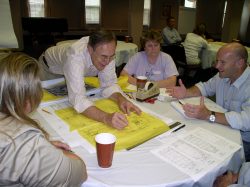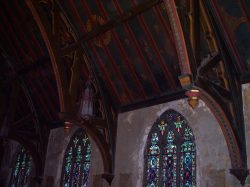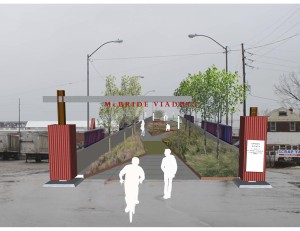At 1pm on Easter Sunday, April 20, 2014, members of the Save the Villa Chapel committee of Preservation Erie will convene for the ninth year in a row at the corner of West 9th and Liberty to provide an update on the status of the landmark chapel. Following the announcement, a brief Easter Parade will be held to celebrate the chapel’s survival through another difficult winter.
On Easter Sunday 2005 a group of concerned citizens gathered to protest the rumored demolition of the Villa Chapel. The resulting Save the Villa Chapel committee has held dozens of fundraisers, raised thousands of dollars, and worked to find an appropriate reuse of the building.
In 2009, Duncan Stroik, a University of Notre Dame professor of architecture and founding editor of Sacred Architecture magazine toured the Villa Chapel and admired the carved woodwork and stained glass saying that the historic building is “a gem that should be saved.” The chapel is on the National Register along with the rest of the Villa Maria complex. The convent and school have been converted to apartments, but the chapel remains vacant, unheated and leaking.
 In 2010, in response to concerns that the chapel was “too far gone to renovate” an engineering expert from Pittsburgh’s Atlantic Engineering was hired to evaluate the building – he indicated that the chapel is stable, but in need of roof and “cosmetic repairs.” In 2011, a reuse planning session (with stakeholders and architects Dave Brennan, Jeff Kidder, Richard Olaya and Ellis Schmidlapp) resulted in a 2012 re-use report drafted by KidderWachter Architecture and Design. The illustrated report details will be available at the Easter Sunday event.
In 2010, in response to concerns that the chapel was “too far gone to renovate” an engineering expert from Pittsburgh’s Atlantic Engineering was hired to evaluate the building – he indicated that the chapel is stable, but in need of roof and “cosmetic repairs.” In 2011, a reuse planning session (with stakeholders and architects Dave Brennan, Jeff Kidder, Richard Olaya and Ellis Schmidlapp) resulted in a 2012 re-use report drafted by KidderWachter Architecture and Design. The illustrated report details will be available at the Easter Sunday event.
Due to the chapel’s uncertain future, Preservation PA placed the Villa Chapel on its list of Pennsylvania at Risk properties in 2011. Dr. Chris Magoc, while serving as Preservation Erie’s Board President, commented that a renovated chapel would “help stimulate community and economic development in a historic Erie neighborhood…”
 While jobs and tax revenues are crucial for a thriving community, Magoc and many others believe that saving the chapel is crucial to preserving our history, identity and sense of place. Mary Frabrizio McCarthy wrote in an Erie Times News opinion piece that Villa Maria grade school, high school and college students met in the chapel “to learn and sing the songs of our faith, songs that have stayed with us throughout our lives.” Another Villa alumna, community leader Sally Carlow Kohler, commented that she has “been fortunate enough to have traveled around the world” but that she returned home to realize that Erie’s Villa Chapel “is one of the most beautiful anywhere!”
While jobs and tax revenues are crucial for a thriving community, Magoc and many others believe that saving the chapel is crucial to preserving our history, identity and sense of place. Mary Frabrizio McCarthy wrote in an Erie Times News opinion piece that Villa Maria grade school, high school and college students met in the chapel “to learn and sing the songs of our faith, songs that have stayed with us throughout our lives.” Another Villa alumna, community leader Sally Carlow Kohler, commented that she has “been fortunate enough to have traveled around the world” but that she returned home to realize that Erie’s Villa Chapel “is one of the most beautiful anywhere!”
Preservation Erie and the Save the Villa Chapel committee believe that Greater Erie must both recognize the importance of becoming a wise steward of its many inherited treasures.

